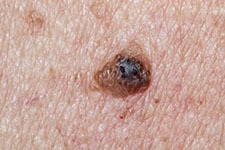Skin Cancer Diagnosis
Diagnosing Skin Cancer – Physical Examination and Biopsies
The first step in diagnosing skin cancer is to have a Skin Cancer Check. Once a suspicious mole, freckle or lesion is identified, there are a few different methods your GP may use to make a diagnosis. Sometimes diagnosis can be made through physical examination of the skin, and other times a skin biopsy or skin excision may be needed to allow further investigation.
Physical Examination of the Skin
Diagnosis begins with a Skin Check. If you notice a new spot, an existing mole or lesion that changes in shape, colour or size, or you have a slow healing sore, or if it’s been more than 12 months since your last skin check, be sure to book an appointment with your GP to have your skin closely examined. Imaging can play a role in diagnosing skin cancer as it tracks the appearance of moles over a period of time to monitor changes.
Biopsies
If your GP notices any areas of concern, they may take a skin biopsy. There are generally two methods, a shave biopsy or a punch biopsy, these are simple, quick, non-invasive procedures and you can return to work immediately. Both skin biopsy methods involve numbing the affected area with a small amount of anaesthetic and taking a small sample of skin which is sent to a laboratory for further analysis. You’ll need to keep a dressing on the biopsy area for 24-48 hours after the procedure, but it is generally painless. In most cases, you’ll get the results via the doctor’s surgery, within a few days.

Excisions
Excision refers to removing an entire skin lesion for evaluation using local anaesthetic. The affected area of the skin is larger than that of a biopsy, as an excision is complete removal of the lesion as well as some of the surrounding tissue which is then sent to a laboratory for evaluation. This helps to ensure all of the cancerous growth is removed. Skin Excisions require stitches and take at least 7 days to heal. If the excision is on the chest or legs, 10 days healing time is applicable, and if the excision is on the back area, there is a longer healing time of 14 days. Patients return to the GP to discuss the diagnosis and to have stitches removed.

Confirming Diagnosis and Results
Results from your biopsy or excision will be sent back to your doctor usually within a week. The results of many biopsies show no cause for concern. On the other hand, results may take longer if more complex tests are required on your skin sample. If your doctor performed a biopsy and cancer is detected, usually your doctor will want to excise (remove) the affected area as the first step in your skin cancer treatment.
Doctors will be in touch to discuss your results and if necessary, book you in for a follow-up appointment. If cancer is present, your treatment options will depend on things such as the nature of the cancer, your lifestyle, and existing or previous medical conditions. Having a thorough understanding of your medical history will help determine the most suitable option to treat the cancer swiftly and effectively.

If you are unsure of the type of appointment to book, please contact Reception in the first instance.
Why Choose RTMC
Caring, friendly doctors
New patients welcome
Easy parking
Quality accreditation
Unique expertise
Patient-centered care
Your Appointment
Use online bookings to make your next appointment quickly and conveniently, any time of day. If your appointment type is not available online, please phone the practice to book.
Robina Town Centre
Easy T Centre